Question :
This assessment will cover following questions:
- Conduct research methodology which integrates knowledge into the research process of the Marks & Spencer.
- Business Research Project is the projects that serves commercial employability experience. Conduct and evaluate the research appropriate to a Marks & Spencer research projects.
- Research projects is the scientific study of the data of the organisation. Communicate the outcome of the research projects to the identified shareholders.
- Reflect on the implementation of the research methodologies and the concepts in the context of Marks & Spencer.
Answer :
CHAPTER 1: INTRODUCTION
1.1 Research Proposal
1) Overview of the research
Diversity and equality in a company assure that all the employees are treated equally and they are given right treatment to perform work at workplace (Cottrill, Denise Lopez and Hoffman, 2014). This research proposal is based on M&S, a UK based retailer of cloth and food that perform their activities globally. This proposal is going to mention about research title, objectives, aim and question. Also, literature source to support objectives will be discussed. Other than this time scale will be mentioned and overview of research methodology will be provided.
2) Research Aim and Objectives
Research aim
“To determine and understand behaviours which denotes the support towards equality and diversity in an organisation”. This research aim has the purpose to acknowledge those factors which assure that elements of diversity and equality are incorporated in M&S in a proper way.
Research Objectives
- To understand the concepts of diversity and equality in a business organisation.
- To determine appropriate strategies used by management in M&S to support D&E in their workplace
- To acknowledge various benefits gained by an organisation while maintaining diversity and equality at their workplace
Research Questions
- What do you understand by concepts like diversity and equality in context with a business organisation?
- What can be potential strategies used by management in M&S to support D&E in their workplace?
- What are the various benefits gained by an organisation while maintaining diversity and equality at their workplace?
3) Reasons for choosing this research project
Main reason of working on this topic is to determine what is the right behaviour for maintaining diversity and equality in an organisation. This topic will help in identifying those practices which can create inequality in a firm due to which overall performance of firm can be hindered. Thus, manager of a company is needed to formulate various strategies so that diversity and equality can be maintained in proper manner (Glatthorn and et. al., 2018). Also, this topic will benefit the researcher in learning and understanding information about right behaviour, managing diversity and equality etc. This will help the researcher in performing future researches appropriately.
4) Activities and Timescales
Work breakdown structure
This is basically a project deliverable which helps in dividing a bulky project into small chuUESTIONNAIREnks of manageable section. In this technique, a project is bifurcated into small sections so that each activity can be given proper consideration and work can be performed in desired manner (Kirton and Greene, 2015).
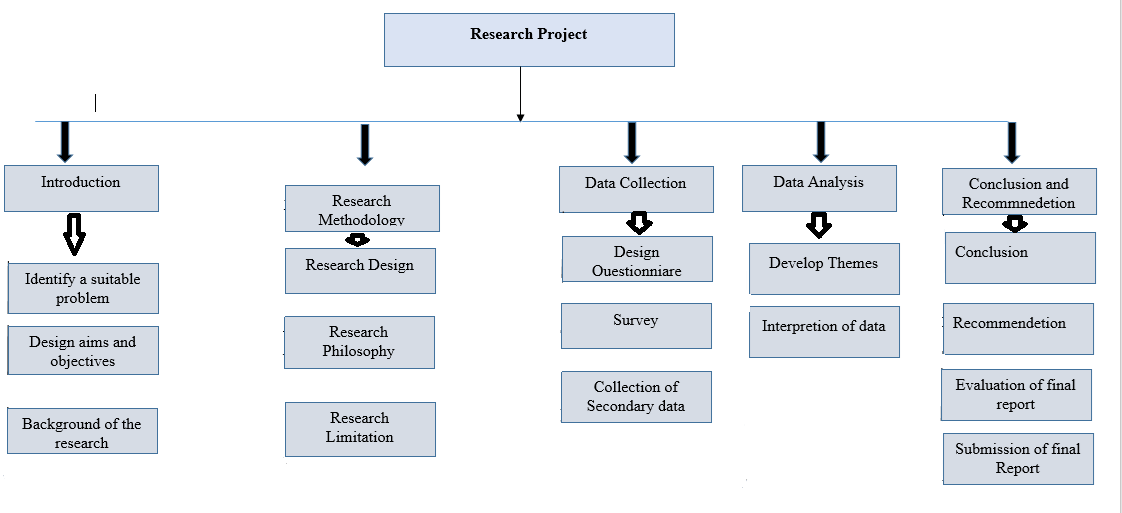
Illustration 1: Work-breakdown structure
Gantt chart
This is basically a visual and graphical presentation of a project in the form of tasks along with their time period so that all the work can be completed within expected time. This chart breaks down a project and denotes the required time to accomplish work. By this, project manager is able to perform those task before which are on priority. By this, overall efficiency of a project is maintained (Adamson and et. al., 2016).
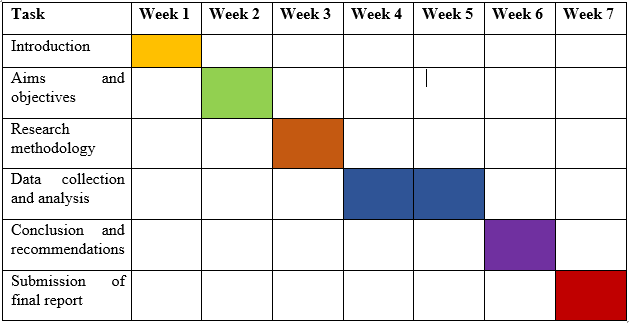
Illustration 2: Gantt chart
CHAPTER 2: LITERATURE REVIEW
2.1 Introduction
It is related to scholarly paper that include the current knowledge involving theoretical contribution and substantive findings to particular research area. Under this part, data and information is collected by using secondary sources such and books, articles, internet sources, journals etc. It is easy and cost saving to collect information from using secondary sources (Altman, 2018).
2.2 Literature review
Diversity and equality in a business organisation
According to opinion of Dr. Kelly S. Meier (2019) Diversity is range of the ethnic, generational and cultural differences present in workplace. On the other hand, equality is treating all the staff members with the equal consideration, race, disability and some other factors. Equality and diversity is promoting an equality of the opportunity by diversity and providing people chance to attain potential, free from discrimination and prejudice. In United Kingdom, organisations are legally required to be adhere practices which assure discrimination is eliminated and also equality expectations are met in workplace. In an organisation, it is necessary to treat all staff members equally and provide them opportunities regardless of their gender, disability, race etc. that may be discriminated against. On the other hand, having diverse workforce, company can provide wide range of resources, skills and ideas to business to provide it competitive edge (Ashe and Nazroo, 2017).
Strategies used by management in M&S to support D&E in their workplace
On the basis of Diane Lynn (2020), Equality and diversity at workplace are necessary to healthy and growing an organisation. employing the people of all races and gander can make company stronger. On the other hand, sometimes diversity arises issues which negatively impact on performance level of employees along with company. To support the equality and diversity, Marks & Spencer uses some strategies at workplace which mention below:
Put equality policies- It is necessary that everyone in company should be fairly treated in daily activities and the work related decisions such as hiring, promotion training etc. There is a need to Marks & Spencer to develop effective discrimination policies and also information all employees regarding the policies of equality (Kirton and Greene, 2015).
Use objective criteria- At the time of recruitment, training and promoting, Marks & Spencer should be assuring about the clear objective criteria and make decisions on the basis of merit. Conduct audit or encouraging the group decision making id there is concern regarding manager and specific team (Konrad, Yang and Maurer, 2016).
Benefits gained by an organisation while maintaining diversity and equality at their workplace
According to Lynn, D. (2019) In order to perform work appropriately, it is important for a company to treat their workers in equal manner. If workers will not be treated equally and feel discriminated in terms of race, gender, religion, caste, nationality etc. then it is not possible for a firm to maintain right kind of behaviour in an organisation. Diversity and equality in a company is very essential as it help the workers in getting fair opportunities so that no employee can feel discriminated. By this, overall productivity of M&S will be high and organisation will be able to achieve expected outcomes. But, if diversity and equality will not be maintained then workers will not be happy and unleashing their full working potential will not be easy.
Student may also like to read: Research on Impact of E-commerce - Amazon
CHAPTER 3: METHODOLOGY
Research methodology is a framework which helps an investigator in performing their work in a systematic manner so that high possible efficiency can be gained while working on a project (Kumar, 2019). There are different kind of research approaches and methods which are mentioned below:
3.1 Research Approaches
Qualitative approach: In this approach, a research is conducted without using any statistics and mathematical formulae. This approach is based on theory and main methods to use this approach are observations, focus groups (Quinlan and et. al., 2019).
Quantitative approach: Under this kind of approach, mathematical calculations and formulae’s are used. Due to this, this approach is time consuming. Methods for this type of approach are questionnaire, interview, surveys etc.
This present research is based on qualitative approach because it gives detailed description regarding the particular field and positive outcomes.
3.2 Methodologies
1) Sampling
It is selection of specific group that denote entire population. In general, probabilistic sampling and non-probabilistic sampling techniques are used. In probabilistic kind of sampling, each respondent is given opportunity share thoughts whereas in non-probabilistic method of sampling, each individual is not an equal part of sample (Roulstone and Williams, 2014). Here, researcher will use probabilistic sampling. Under this sampling approach, researcher is going to select the respondents on random basis. There are 30 respondents has been chosen by using random sampling method.
Data collection is method of gathering data from using reliable sources. Primary and secondary are two types of data collection methods which mention below:
Primary methos: In this type of method, an information is collected for the first time and use for a specific reason. This method is very cost and time consuming (Larrieta‐Rubín de Celis and et. al., 2015). This research can be conducted in the form of questionnaire, surveys, focus groups etc.
Secondary method: In this kind of research, a person collects required data from books, internet, magazines, Journals etc. This data is already collected by some individual for their research. Due to this, conducting this research is very cost and time effective.
2) Data analysis
It is related to inspecting and modelling data with aim of finding useful data and supporting decision making. Under this, an investigator will analyse the data and information for the success of project or research. Data analysis is process of evaluating data through using analytical and statistical tools in order to find authentic information in process of decision making (Marinova, Planteng and Remery, 2016). In order to analysing data, thematic analysis will be used and it aids in interpret information by questionnaire. The gathered information is segregated in different themes which will assist in conducting analysis of information.
3) Cost, access and ethical considerations
In an investigation, ethics is main area that need to be consider while conducting any research activities effectively. Ethics is explained as values, principles, beliefs and norms which require to be adopt while including the research activities. It is necessary to keep the data and information of respondents confidential so that proper trust can be build. On the other hand, investigator is responsible in arrange money so that all the activities involved in research can be completed and proper outcomes attained. It is essential that sources to gather information and data should be reliable and confidential (Martinsson and Griffin, 2016). Researcher is responsible to conduct research work according to developed guidelines and principles.
Related Services : Dissertation Help
CHAPTER 4: DATA COLLECTION AND ANALYSIS
4.1 Data collection
It is explained as collecting and analysing accurate information through using effective techniques. In this, researcher can examine the hypothesis on the basis of collected information and data. Two different types of data collection are mention below:
- Primary method- Under this, researcher gather fresh information and it is original in nature. Sources to gather the primary information are questionnaire, focus groups, observations etc. In present investigation, questionnaire method has been used to collecting reliable information on particular subject (Mertkan and et. al., 2017).
- Secondary method- In this, data has been collected already by someone. Sources to collecting secondary data are journals, articles, internet sources etc. it is used in doing the literature review through considering viewpoints of various authors on specific area (Moor and Tailby, 2015).
4.2 Data analysis, presentation and discussion
Under this, data will be analysing by using thematic analysis. The themes will be developing along with interpretation. The data will be analysing on the basis of information included in questionnaire. In relation to this, questionnaire is communication to the management of a team in Marks & Spencer (Schachner and et. al., 2016). They will be more interested in research outcomes because this assist in identify effectiveness of company products, to communicating with management, email is better method.
|
QUESTIONNAIRE Q1) Do you have information related to equality and diversity at workplace? a) Yes b) No Q2) In which manner, equality and diversity impact on organisational productivity? a) Positive manner b) Negative manner Q3) What are the advantages of equality and diversity to Marks & Spencer? a) Promotes innovation b) Improve brand reputation c) Add new skills to teams d) Opens up new talent Q4) On which basis company discriminated employees at workplace? a) Age b) Gender c) Race d) Ethnicity Q5) Does diversity impact on the performance level of Marks & Spencer staff members? a) Yes b) No |
|
Q6) What complexities Marks & Spencer company faces related to equality and diversity at workplace? a) Arising conflict b) Reduce employee morale c) High employee turnover d) Minimize organisational productivity Q7) What are the different strategies management of Marks & Spencer can use to support Diversity and Equality at workplace? a) Prevent unconscious bias b) Put equality policies c) Use objective criteria Q8) What are the benefits gained by Marks & Spencer organisation while maintaining diversity and equality at their workplace? a) Reduce employee turnover b) Positive working environment c) Enhance organisation profit Q9) Recommend some ways by which company can gain competitive environment from removing issues related to equality and diversity. |
DATA SHEET
| Q1) Do you have information related to equality and diversity at workplace? | Frequency |
| a) Yes | 28 |
| b) No | 2 |
| Q2) In which manner, equality and diversity impact on organisational productivity? | Frequency |
| a) Positive manner | 25 |
| b) Negative manner | 5 |
| Q3) What are the advantages of equality and diversity to Marks & Spencer? | Frequency |
| a) Promotes innovation | 5 |
| b) Improve brand reputation | 10 |
| c) Add new skills to teams | 10 |
| d) Opens up new talent | 5 |
| Q4) On which basis company discriminated employees at workplace? | Frequency |
| a) Age | 12 |
| b) Gender | 5 |
| c) Race | 7 |
| d) Ethnicity | 6 |
| Q5) Does diversity impact on the performance level of Marks & Spencer staff members? | Frequency |
| a) Yes | 20 |
| b) No | 10 |
| Q6) What complexities Marks & Spencer company faces related to equality and diversity at workplace? | Frequency |
| a) Arising conflict | 15 |
| b) Reduce employee morale | 8 |
| c) High employee turnover | 5 |
| d) Minimize organisational productivity | 2 |
| Q7) What are the different strategies management of Marks & Spencer can use to support Diversity and Equality at workplace? | Frequency |
| a) Prevent unconscious bias | 10 |
| b) Put equality policies | 10 |
| c) Use objective criteria | 10 |
| Q8) What are the benefits gained by Marks & Spencer organisation while maintaining diversity and equality at their workplace? | Frequency |
| a) Reduce employee turnover | 10 |
| b) Positive working environment | 10 |
| c) Enhance organisation profit | 10 |
| Q1) Do you have information related to equality and diversity at workplace? | Frequency |
| a) Yes | 28 |
| b) No | 2 |
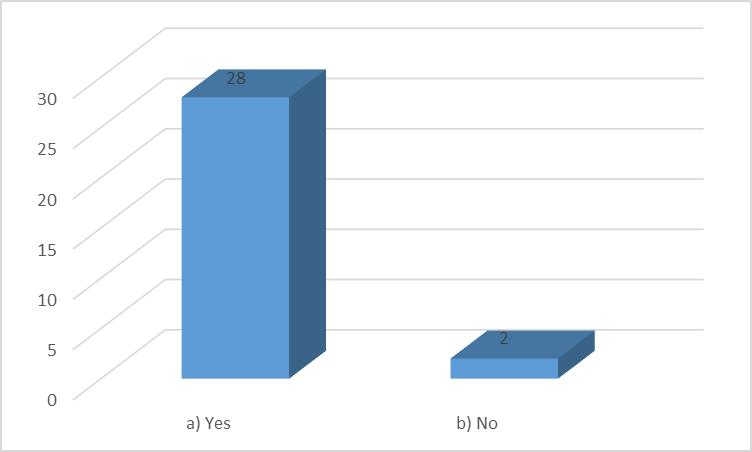
Interpretation: On the basis of 28 respondents that they have the better knowledge regarding equality and diversity at the workplace. They have the understanding regarding this. Remaining 2 respondents do not have information regarding this and they cannot able to give information properly.
THEME 2: Equality and diversity impact on organisational productivity
| Q2) In which manner, equality and diversity impact on organisational productivity? | Frequency |
| a) Positive manner | 25 |
| b) Negative manner | 5 |
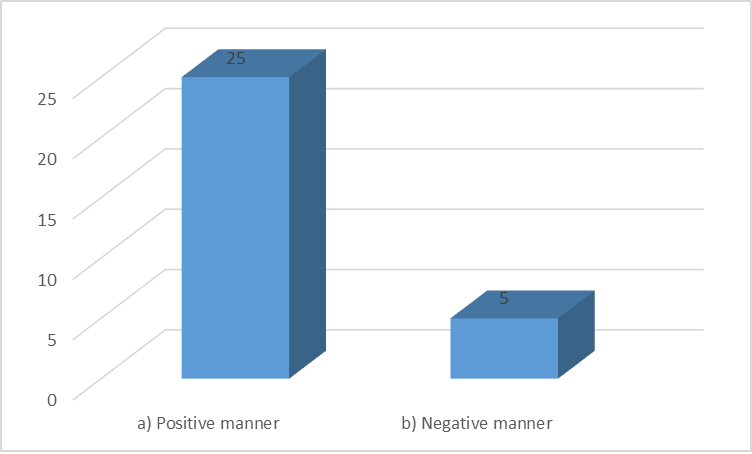
Interpretation: Equality and diversity impact on organisational productivity in negative and positive manner. There are 25 respondents which said that equality and diversity positively impact on productivity of company because it creates innovation and also treat all employees equally so that they can work effectively and give their better performance. On the other hand, according to 5 respondents that people belong to different background and they are unaware about different culture so chances of conflict arise and negative environment can be developed.
THEME 3: Advantages of equality and diversity to Marks & Spencer
| Q3) What are the advantages of equality and diversity to Marks & Spencer? | Frequency |
| a) Promotes innovation | 5 |
| b) Improve brand reputation | 10 |
| c) Add new skills to teams | 10 |
| d) Opens up new talent | 5 |
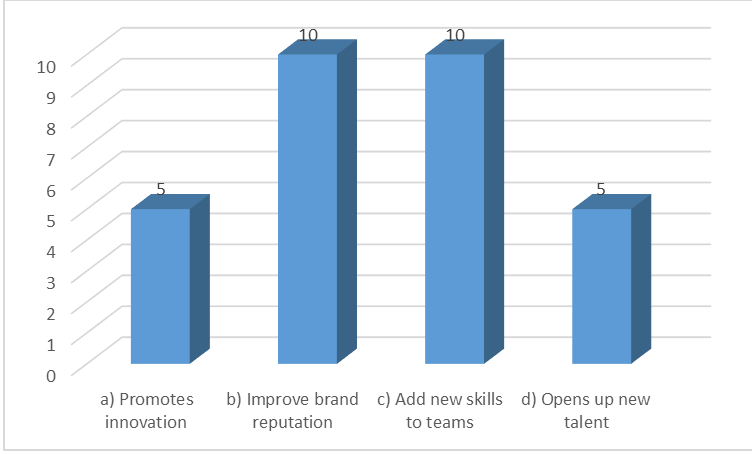
Interpretation: From mention graph, equality and diversity provide some benefits to company. There are 5 respondents and according to this, equality and diversity promoted innovation because people belongs to different background have different mind-set and by working together they can make innovation. According to 10 respondents that at workplace equality and diversity make improvement in brand reputation through bringing up the new talent. There are 10 respondents which said that it helps in ad the new skills in to teams. 5 respondents are agreeing with open up the new talent.
THEME 4: Basis company discriminated employees at workplace
| Q4) On which basis company discriminated employees at workplace? | Frequency |
| a) Age | 12 |
| b) Gender | 5 |
| c) Race | 7 |
| d) Ethnicity | 6 |
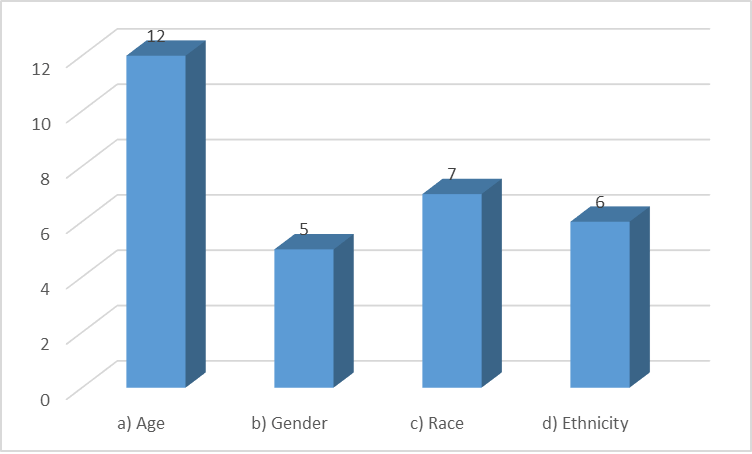
Interpretation: From given graph, this has been shown that there is different basis on which company can discriminate the employees at workplace. As per opinion of 12 respondents that on the basis of age company makes discrimination. The age discrimination includes treating workers less favourable due to age. 5 respondents said that discrimination among the male and female arising issues. According to 7 respondents that race discrimination consist treating someone unfavourably due to personal characteristics. 6 remaining respondents are agreeing with ethnicity basis.
THEME 5: Diversity impact on the performance level of staff members
| Q5) Does diversity impact on the performance level of Marks & Spencer staff members? | Frequency |
| a) Yes | 20 |
| b) No | 10 |
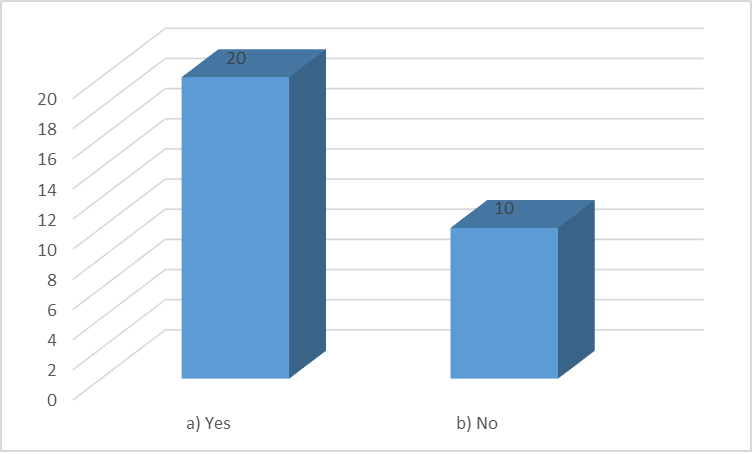
Interpretation: Diversity is related to treating employees differently in determining features between members of defined group. There are 20 respondents and according to them, diversity impact on employee’s performance. In this, employer judge the people on the basis of different factors and this reduces the morale of staff members. On the other hand, there are 10 remaining respondents which are not agree with this statement and according to them diversity gives some benefits to company and develop positive impact on performance level of employees.
THEME 6: Complexities Marks & Spencer company faces related to equality and diversity
| Q6) What complexities Marks & Spencer company faces related to equality and diversity at workplace? | Frequency |
| a) Arising conflict | 15 |
| b) Reduce employee morale | 8 |
| c) High employee turnover | 5 |
| d) Minimize organisational productivity | 2 |
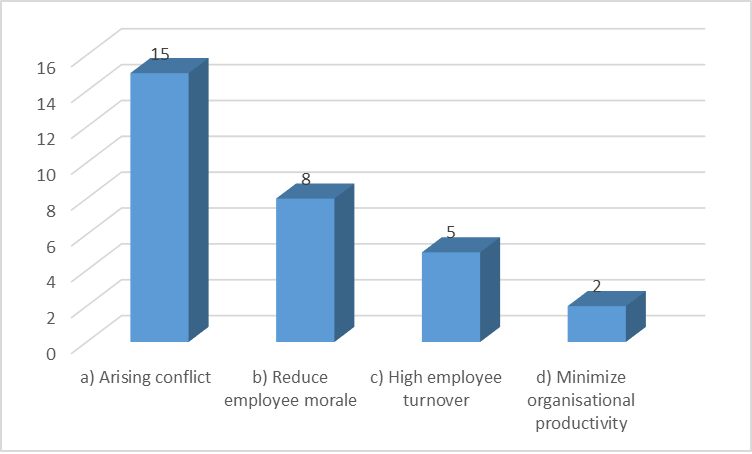
Interpretation: From the equality and diversity, some complexities arise at workplace. According to 15 respondents that equality and diversity is a main reason of arising conflict due to the differences at workplace. 8 respondents said that diversity minimizes morale of staff members. 5 respondents said that equality and diversity reduce the morale of employees because employer does not treat employees equally. There are 5 respondents and according to them diversity enhance the employee turnover rate. 2 respondents are agreeing with reduce organisational productivity.
THEME 7: Strategies management of Marks & Spencer can use to support Diversity and Equality
| Q7) What are the different strategies management of Marks & Spencer can use to support Diversity and Equality at workplace? | Frequency |
| a) Prevent unconscious bias | 10 |
| b) Put equality policies | 10 |
| c) Use objective criteria | 10 |
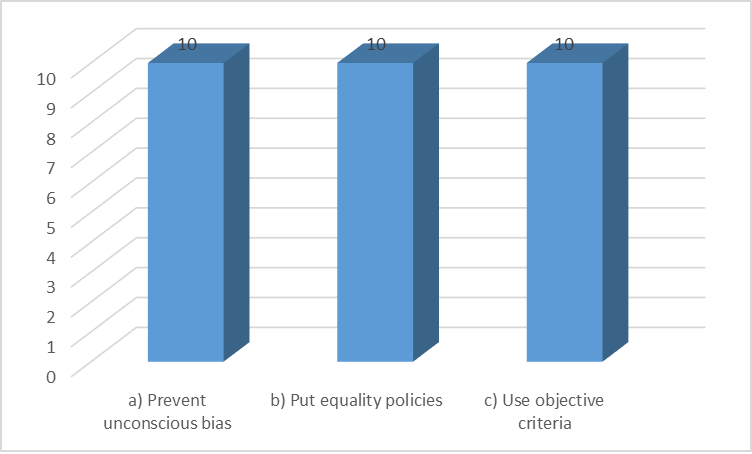
Interpretation: To support the Diversity and Equality at workplace, Marks & Spencer company uses different strategies. There are 10 respondents and according to them company should prevent the workplace environment from any kind of biasness so that employees can not feel demotivated. As per opinion of 10 respondents that Marks & Spencer need to put it all equality policies. 10 remaining respondents are agreeing with use of objective criteria.
THEME 8: Benefits gained by Marks & Spencer organisation while maintaining diversity and equality
| Q8) What are the benefits gained by Marks & Spencer organisation while maintaining diversity and equality at their workplace? | Frequency |
| a) Reduce employee turnover | 10 |
| b) Positive working environment | 10 |
| c) Enhance organisation profit | 10 |
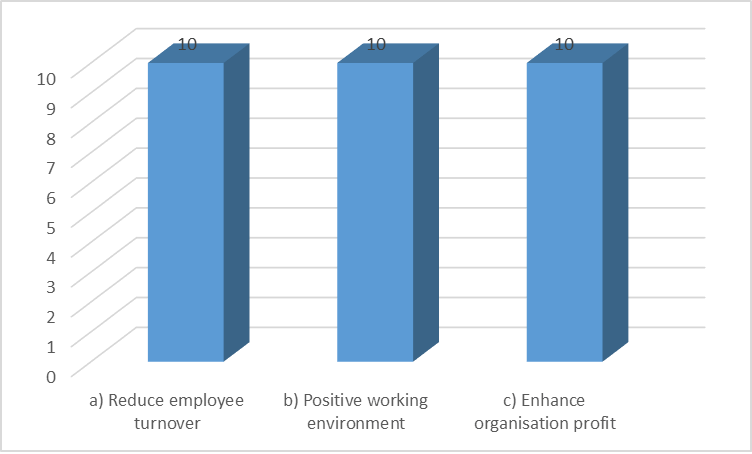
Interpretation: From managing or maintaining the equality and diversity at workplace, Marks& Spencer company gained some advantages. There are 10 respondents and they said that from removing the diversity issues at workplace, the employee turnover will be reduced. 10 respondent said that from managing the equality and diversity at workplace, positive working environment will be developed. 10 respondents are agreeing with increasing the profit f company.
CHAPTER 5: CONCLUSIONS AND RECOMMENDATIONS
5.1 Conclusion
With the help of above mentioned investigating report, it is being concluded that equality and diversity is said to be something that mainly plays an important role for a business organisation when it comes to grab a good position within the market for a longer period of time. Including this, it is said that different behaviour along with the culture followed by a diversified employee group of a business organisation may go through ample number of problems, which may lead to face various losses in regards to profit, sales and revenue. Including this, considering appropriate strategy like developing an effective policy linked with all the different needs and requirements of customers could enhance the performance level along with the employee engagement as well towards common goals and objectives.
Away with this, it is also summarised that for a business organisation's management, it is needed to monitor the problems faced by staff and keep on resolving them as this would lead firm to reduce the high employee turnover ratio. Including this, it is also said that diversified workforce needs proper attention as well that is directly linking with number of goals and objectives in a short span. Along with this, it is also said that treating staff equally could also help a firm in treating fairly as this will also enhance the motivation level as well of staff and so on. Through developing or creating a much more effective and inclusive culture for all staff would help firm in gaining good reputation among customers and staff as well.
5.2 Recommendations
Considering the above mentioned information, there are number of recommendations that can be delivered and these are:
- It is recommended that, it will be required by ensuring equal access to opportunities to enable staff to fully participate in the learning process. With the help of this, Marks & Spencer may also sustain within the market for a longer period of time, as it will enhance the engagement of staff towards particular goal or objectives as well.
- Another crucial recommendation that is being given to Marks & Spencer is that it will be required by them to keep on training staff towards each other's culture and offer them right opportunities like group discussions and so on, which may aid them in building relationship with each other.
- Including this, ensuring procedures, policies and processes are also needed proper control and monitoring as well so that no discrimination is taking place at workstation.
- Marks & Spencer may also require to develop knowledge of different areas of the community as this would easily be utilised to maintain the right decorum of workstation.
- Including this, it is also said that contrasting perspectives will be encouraged, which can lead to improved team productivity and success of the business organisation like Marks & Spencer in sustaining at market for a longer period of time.
CHAPTER 6: PERSONAL REFLECTIVE STATEMENT
6.1 Reflect on research methods used in project
Under present investigation, research methods have been used for conducting an investigation effectively. There has been qualitative research approach and primary method of data collection used. For gathering information, I developed questionnaire on the basis of research objectives. My main reason behind using questionnaire is that it is easy to gather the information from large number of people within less time period.
6.2 Consider research methods that could have been used
In this, Interview research method that could have been used. In an interview, interviewer and interviewee are involved. An interviewer coordinated process of conversation and also asks some questions from interviewee. In is an appropriate research method because there is requirement of gather an in-depth information on experiences, feelings and opinions of people.
6.3 Areas for further research
In this, reason to conducting an investigation is to address conflict through examining information gathered from various sources. Present research taken in to consideration on identify and acknowledge those behaviours which support aspects of diversity and equality at workplace in an appropriate manner. It provides the relevant information and increasing knowledge related to equality and diversity and issues arisen from this at workplace. It is wider investigation area that assist in developing knowledge of research in particular area. This will develop value in improving personal and professional abilities in an effective way. Through conducting investigation, knowledge regarding research methodologies and data collection which help in carried put an investigation effectively. In future, this research helps in increasing the skills and able to gain positive outcomes effectively.
Students May Also Like to Read: Learn Decision-Making Process Through Research
REFERENCES
- Cottrill, K., Denise Lopez, P. and C. Hoffman, C., 2014. How authentic leadership and inclusion benefit organizations. Equality, Diversity and Inclusion: An International Journal.33(3). pp.275-292.
- Glatthorn, A. A., and et. al., 2018. Curriculum leadership: Strategies for development and implementation. SAGE publications.
- Kirton, G. and Greene, A. M., 2015. The dynamics of managing diversity: A critical approach. Routledge.
- Kirton, G. and Greene, A. M., 2015. The dynamics of managing diversity: A critical approach. Routledge
- Konrad, A. M., Yang, Y. and Maurer, C. C., 2016. Antecedents and outcomes of diversity and equality management systems: An integrated institutional agency and strategic human resource management approach. Human Resource Management. 55(1). pp.83-107.
- Kumar, R., 2019. Research methodology: A step-by-step guide for beginners. Sage Publications Limited.
- Larrieta‐Rubín de Celis, I. and et. al., 2015. Does having women managers lead to increased gender equality practices in corporate social responsibility?. Business Ethics: A European Review. 24(1). pp.91-110.
- Marinova, J., Plantenga, J. and Remery, C., 2016. Gender diversity and firm performance: Evidence from Dutch and Danish boardrooms. The International Journal of Human Resource Management. 27(15). pp.1777-1790.
- Martinsson, L. and Griffin, G. eds., 2016. Challenging the myth of gender equality in Sweden. Policy Press.

























